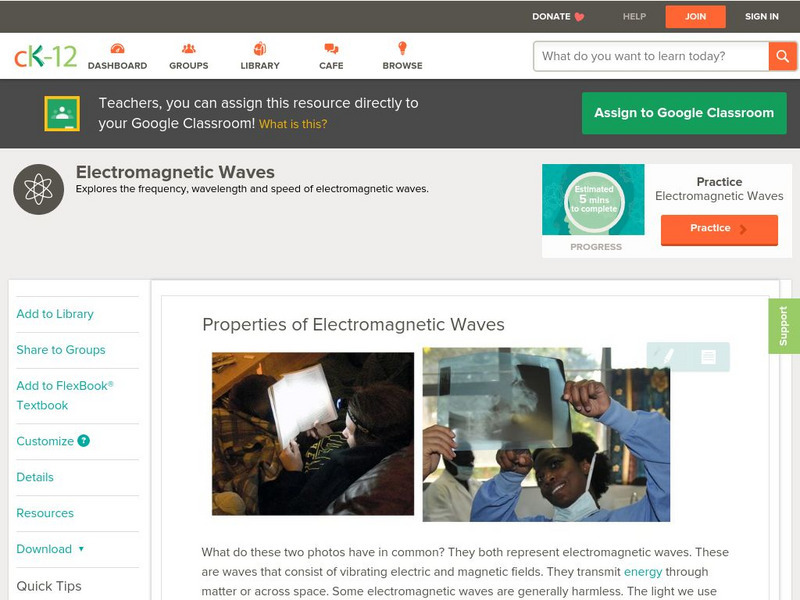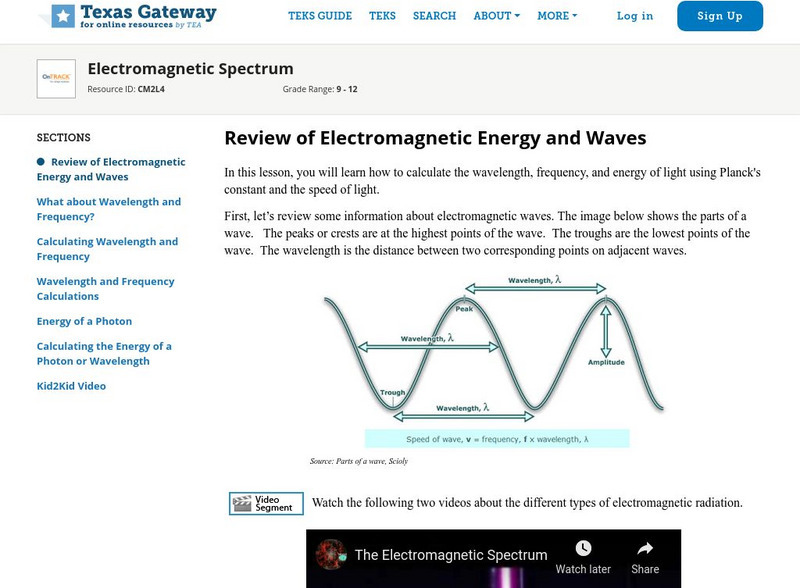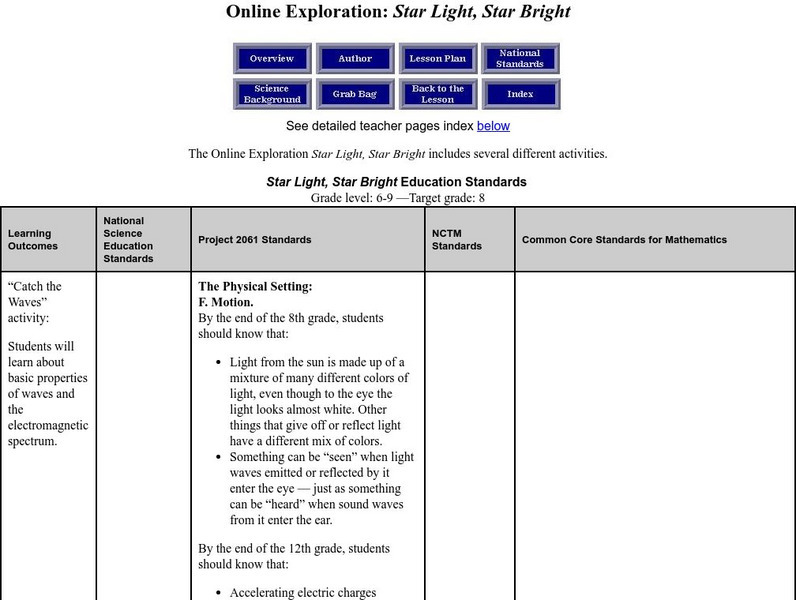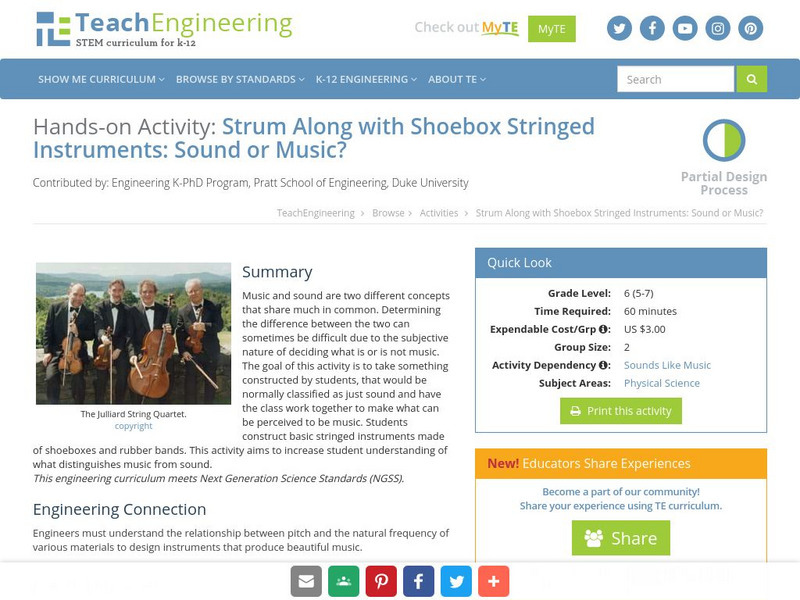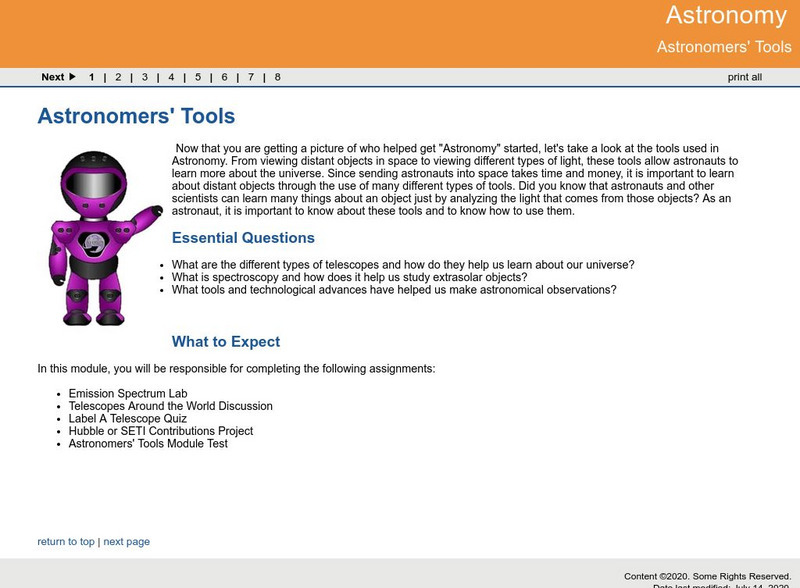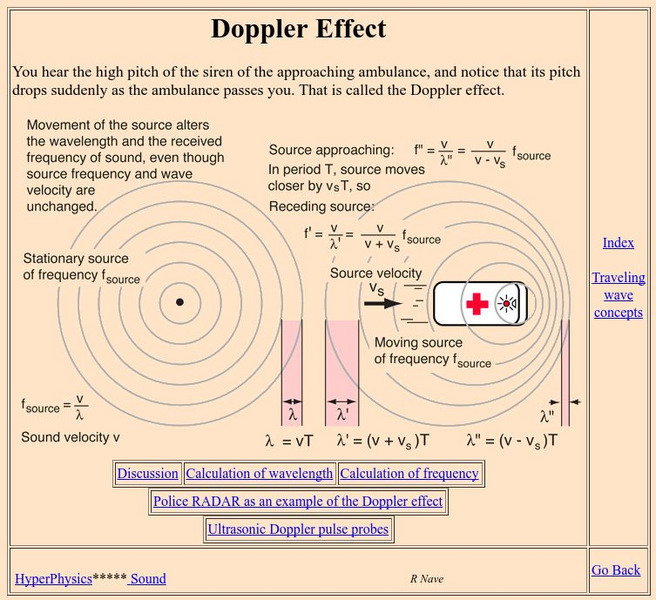CK-12 Foundation
Ck 12: Physical Science: Properties of Electromagnetic Waves
[Free Registration/Login may be required to access all resource tools.] The speed of electromagnetic waves, their wavelengths and frequencies and how to calculate wavelength or wave frequency.
Open Curriculum
Open Curriculum: Frequency, Wavelength, and Pitch
To provide an overview of the relationship between frequency, wavelength, and pitch
Science Education Resource Center at Carleton College
Serc: Calculating the Speed of Sound
In this physical science lab, students will calculate the speed of sound. They will observe that the speed of sound is constant, regardless of wavelength or frequency, and see the inverse relationship between wavelength and frequency.
Physics Aviary
Physics Aviary: Practice Problems: Wave Equation
This program asks students to determine the variables in a wave equation. Students must determine wavelength, frequency, and amplitude.
Georgia State University
Georgia State University: Hyper Physics: Wave Motion
Two wave graphs depicting a sine wave and relating the various characteristics (wavelength, amplitude, frequency, and period) of a wave to each other. The site includes an interactive JavaScript form in which the visitor enters one...
Physics Classroom
The Physics Classroom: The Wave Equation
A thorough explanation of the wave equation (Speed = Wavelength * Frequency). A data table and questions to check one's understanding are also part of this lesson.
Texas Education Agency
Texas Gateway: Physics of Hearing: Summary
This page provides a summary of the content of each section of Chapter 17: Physics of Hearing from the AP Physics online text.
CK-12 Foundation
Ck 12: Electromagnetic Spectrum
[Free Registration/Login may be required to access all resource tools.] Students learn what an electromagnetic wave is, gain a feel for the main parts of the spectrum, and work on problems involving basic properties of electromagnetic...
Texas Education Agency
Texas Gateway: Electromagnetic Spectrum
This tutorial explores using Planck's constant and the speed of light to calculate the wavelength, frequency, and energy of light.
CK-12 Foundation
Ck 12: Transverse Waves
[Free Registration/Login may be required to access all resource tools.] Explore the characteristics and behaviors of energy transferred by transverse waves.
Space Telescope Science Institute
Amazing Space: Star Light, Star Bright
This online exploration provides an opportunity to identify the different properties of waves and the relationship that exists between energy, wavelength, and frequency. Correlate images from the Hubble Telescope to the wavelength,...
CK-12 Foundation
Ck 12: Electromagnetic Waves
[Free Registration/Login may be required to access all resource tools.] In this learning module, compare characteristics and behaviors of transverse waves, including electromagnetic waves.
University of Colorado
University of Colorado: Physics 2000: More About Visualizing Electromagnetic Waves
Discusses the nature of an electromagnetic wave. Explains the oscillating electric field and represents it through clever graphics and animations.
TeachEngineering
Teach Engineering: Strum Along
Music and sound are two different concepts that share much in common. Determining the difference between the two can sometimes be difficult due to the subjective nature of deciding what is or is not music. The goal of this activity is to...
Ducksters
Ducksters: Physics for Kids: Properties of Waves
Kids learn about the properties waves in the science of physics including amplitude, wavelength, frequency, period, and speed.
ClassFlow
Class Flow: Electromagnetic Spectrum
[Free Registration/Login Required] In this Flipchart, students are introduced to the electromagnetic spectrum. Students will learn the names of the types of waves, and the order in which they are arranged. Additionally, students will...
Georgia Department of Education
Ga Virtual Learning: Astronomers' Tools
In this interactive tutorial students will learn about a few of the instruments used to further our knowledge of the Universe around us.
Physics Aviary
Physics Aviary: Practice Problems: Sound Wave Problem
Determine the speed of a sound wave through an alien atmosphere. You must also find the frequency of the wave source and the wavelength of the wave.
Georgia State University
Georgia State University: Hyper Physics: Traveling Wave Relationship
Online physics text that illustrates and explains the various characteristics of waves such as amplitude, period, frequency, wavelength, and speed. Includes interactive exercises.
Concord Consortium
Concord Consortium: Stem Resources: How Loud, How High?
What are ways to describe sound? Using the program downloaded called Sound Grapher and the microphone on the computer, students can investigate the frequency, wavelength, amplitude, and velocity of sound waves. Activity includes detailed...
Florida State University
Florida State University: Basic Electromagnetic Wave Properties
This Florida State University page includes an interactive java tutorial that explores the relationship between frequency, wavelength, and energy, and enables the visitor to adjust the intensity of the radiation and to set the wave into...
University of California
Uc Berkeley: Radio Spectrum
From a course titled "Structure and Interpretation of Signals and Systems." A discussion of the entire radio spectrum, listing wavelength and frequency values for its various parts. The uses of each region of the radio spectrum is...
Georgia State University
Georgia State University: Hyper Physics: Doppler Effect
This hypertext physics course page illustrates and explains the Doppler effect. Users perform practice calculations for frequency shifts using the Doppler equation.
Space Telescope Science Institute
Amazing Space: Star Light, Star Bright
An online exploration where students learn the basics about light and the properties of waves and the electromagnetic spectrum. Students will also learn how to measure wavelength and frequency so they can understand the electromagnetic...
